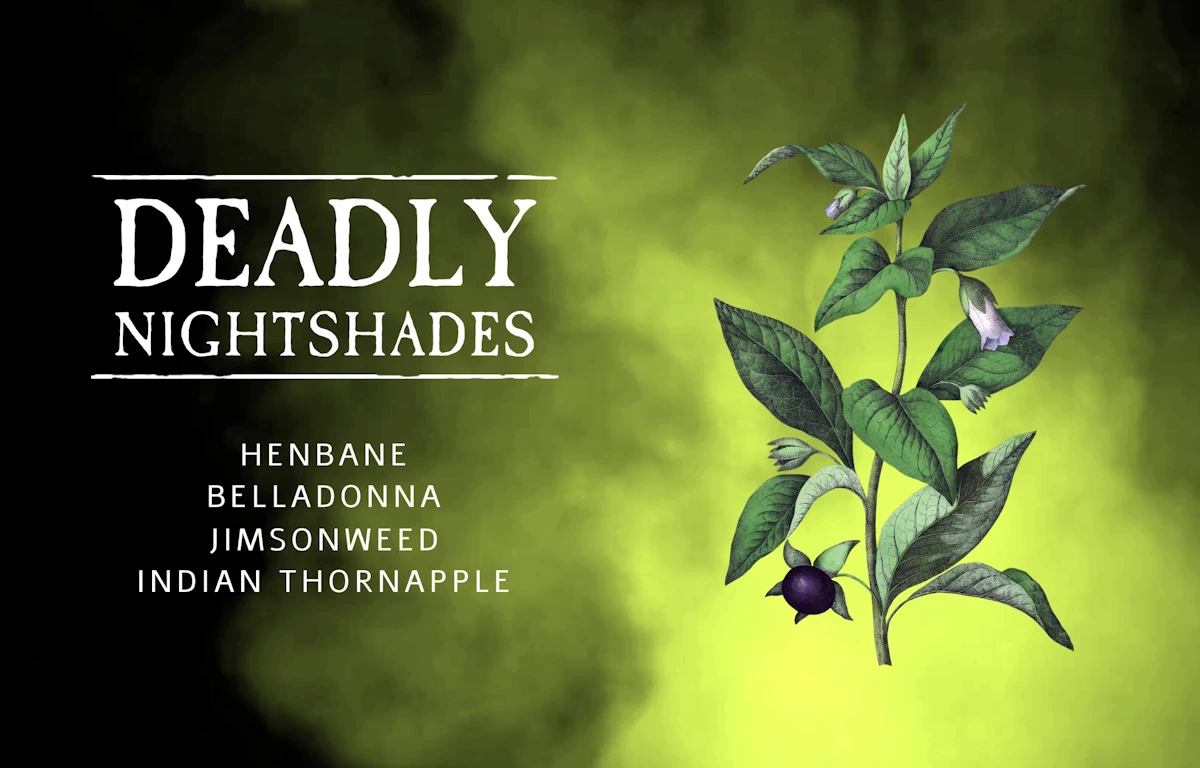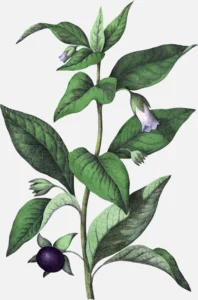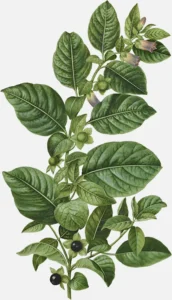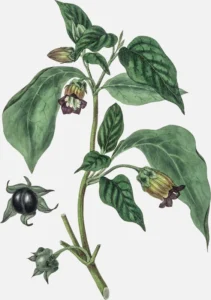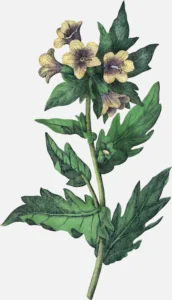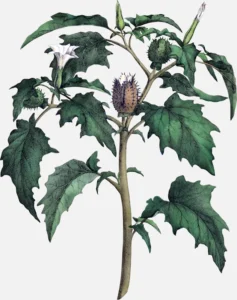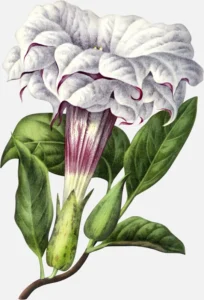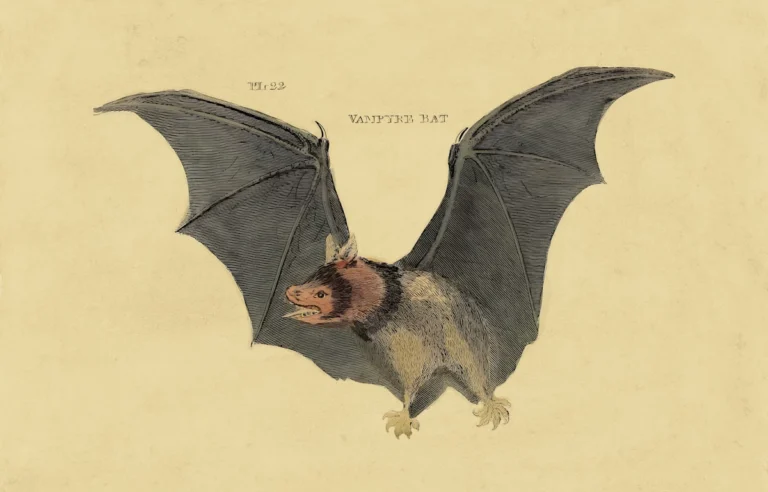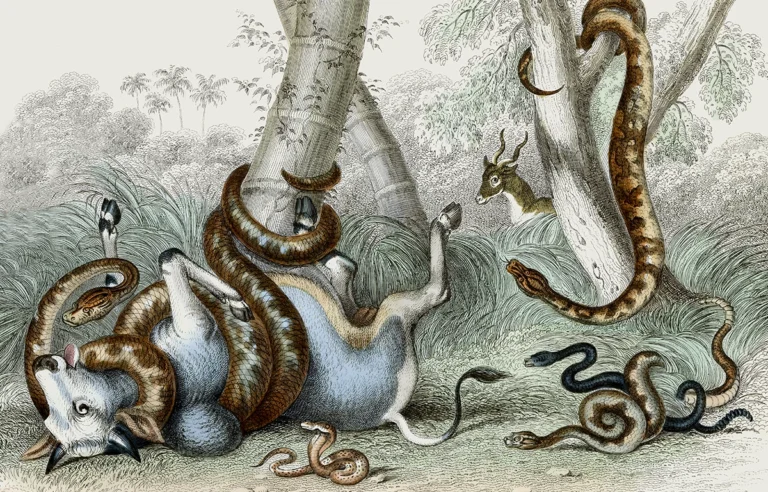Poisonous Nightshades: Deadly Plants with a Dangerous History
The nightshade family, or Solanaceae, is like a botanical mixed bag. While it includes delicious foods like potatoes, tomatoes, peppers, and eggplants, some of its members are downright deadly. Imagine biting into a tasty tomato only to find out its relatives are poisonous! Yes, some of these toxic plants are infamous for their dark history. Let’s dive into the dangerous world of nightshades, exploring some of their most notorious members: Belladonna, Henbane, Jimsonweed, and Indian Thornapple, plus two more intriguing members: Mandrake and Tobacco.
Belladonna: The Beautiful Killer
Belladonna, also known as deadly nightshade, is a real troublemaker. Its scientific name is Atropa belladonna, but you might want to remember the “deadly” part! This plant looks like something straight out of a fairy tale with its dark, shiny berries and glossy leaves. But don’t let its good looks fool you; it’s packed with toxins. The berries might seem like tempting little jewels, but eating them can cause serious trouble.
Belladonna contains chemicals called alkaloids, including atropine, scopolamine, and hyoscyamine. These substances are like the plant’s secret weapon. Atropine can make your heart race, while scopolamine might make you see things that aren’t there. And if you’ve had enough of that, hyoscyamine can make you so confused that you don’t know which way is up.
Historically, Belladonna wasn’t just a weapon or a beauty product—it also played a role in medicine. In the 19th century, doctors discovered that atropine could be used to treat various conditions, including motion sickness and muscle spasms. But handling Belladonna requires precision because a tiny mistake can turn a helpful dose into a lethal one. Interestingly, Belladonna was also used in some old-fashioned remedies for sore throats and coughs, though with varying degrees of success. Its reputation as both a poison and a medicine highlights the thin line between danger and healing.
Despite its deadly nature, Belladonna had its glamorous side. In Renaissance Italy, the name “Belladonna” means “beautiful woman,” and it was used as a cosmetic. Women would put drops of Belladonna in their eyes to make their pupils dilate, which was considered attractive at the time. Unfortunately, this practice often led to blindness, so it’s not exactly the best beauty tip. In Romania, especially in the region of Bukovina, Belladonna was linked to rituals. Young women would dig up the plant’s roots during the festival of Shrovetide, leaving behind gifts like bread, salt, and brandy. They would then carry the root home, believing the secrecy of their actions would make the magic work better.
Henbane: The Witch’s Plant
Henbane, or Hyoscyamus niger, has a name that sounds like it might be related to chickens, but it’s actually a lot scarier. Sometimes called “black henbane” or “stinking nightshade,” this plant is known for its foul smell and hallucinogenic effects. Its name has been around since at least 1265, and the “hen” in its name actually refers to death, not poultry.
Henbane has been a favorite of ancient Greeks and medieval witches alike. The Greeks burned Henbane and inhaled the smoke to enter trances and make prophecies. Imagine being able to see the future just by breathing in the smoke of a stinky plant! In medieval times, Henbane was feared for its supposed links to witchcraft. It was said that witches used Henbane in potions to summon spirits or make magical ointments.
These potions were applied to the skin or mucous membranes, like the armpits or even more private areas. It might sound strange, but applying Henbane this way allowed witches to experience its effects without getting a stomachache. Some historians even think Viking warriors might have used Henbane to go into a fierce rage during battles. Before hops became the standard ingredient in beer, Henbane was also used in brewing for its intoxicating effects. However, after the Bavarian Purity Law of 1516 came into play, which only allowed barley, hops, yeast, and water in beer, Henbane’s brewing days were over.
In addition to its magical and medicinal uses, Henbane also had a place in early herbal medicine. It was sometimes used to treat conditions like headaches and sleep disorders. However, because of its potent effects, it was often used with great caution. Its historical role in medicine and magic reflects how people have long wrestled with the dangers and benefits of such powerful plants.
Jimsonweed: The Devil’s Snare
Jimsonweed, or Datura stramonium, is another plant that belongs to the nightshade family, and it definitely lives up to its nickname, “devil’s snare.” It also goes by names like thorn apple and devil’s trumpet. This plant is notorious for its potent chemicals—atropine, hyoscyamine, and scopolamine—that can cause severe hallucinations, confusion, and even death if too much is consumed.
Jimsonweed has a fascinating history in indigenous cultures. Native American tribes like the Aztecs, Navajo, and Cherokee used it in religious ceremonies to induce visions and spiritual experiences. In Haiti, the plant is called “zombie cucumber” and is used in voodoo rituals. It’s said that Jimsonweed plays a role in creating zombies in Haitian folklore, which sounds like something straight out of a horror movie!
Jimsonweed’s reputation for causing hallucinations and delirium has also made it famous in witchcraft lore. Like Belladonna and Henbane, it was used in magical ointments applied to the skin. These ointments were absorbed through the skin, leading to powerful hallucinations that were thought to be magical in nature. One famous incident involving Jimsonweed occurred during Bacon’s Rebellion in 1676 in Jamestown, Virginia. British soldiers accidentally ate Jimsonweed, mistaking it for something harmless, and spent the next 11 days in a state of complete delirium. They were found acting strangely—sitting naked in trees and generally causing chaos.
Jimsonweed has also left its mark on the art world. American painter Georgia O’Keeffe was fascinated by the plant, and her painting “Jimson Weed/White Flower No. 1” became the highest-priced work by a female artist when it sold for $44.4 million at auction in 2014. Talk about making a splash in the art world! Additionally, Jimsonweed’s striking appearance, with its trumpet-shaped flowers and spiky seed pods, has made it a favorite subject for botanical illustrations.
Indian Thornapple: Dangerous Medicine
Indian thornapple, or Datura metel, is another plant in the nightshade family that packs a punch. It has powerful hallucinogenic and toxic effects, with every part of the plant being dangerous. Just a small amount can lead to severe symptoms like convulsions, hallucinations, or even coma.
Despite its toxicity, Indian thornapple has been used in traditional medicine for a long time. In Ayurveda, the ancient Indian system of medicine, it’s been used to treat asthma, coughs, and pain. But don’t be fooled—using this plant requires extreme caution because the line between a helpful dose and a deadly one is very thin.
In Hinduism, Indian thornapple is connected to religious rituals. It’s often offered to the god Shiva, reflecting its spiritual significance. The plant’s powerful hallucinogenic properties have made it part of shamanistic practices in India and Southeast Asia. Shamans sometimes use it in spiritual rituals, believing it helps them communicate with the spirit world. The dual nature of Indian thornapple—as both a dangerous and revered plant—shows how humans have long wrestled with the power and peril of nature.
Indian thornapple’s physical appearance is also quite striking. Its flowers are trumpet-shaped and can range in color from white to purple, while its spiky seed pods resemble something out of a medieval fantasy. This dramatic look adds to its allure and mystique, making it a popular subject in folklore and traditional medicine.
Mandrake: The Human-Shaped Root
The mandrake, or Mandragora officinarum, is perhaps one of the most famous nightshades due to its peculiar, human-shaped root. This root has been the stuff of legends, with ancient beliefs suggesting that pulling up a mandrake root would cause the plant to emit a scream so deadly it would kill anyone who heard it.
Mandrake’s role in folklore extends far beyond just the scream legend. In ancient Rome, the root was associated with fertility and was believed to have magical properties that could enhance sexual desire and aid in childbirth. The plant’s use in magical rituals continued through the Middle Ages and into the Renaissance, where it was included in various spells and potions.
In addition to its mystical reputation, the mandrake has had practical uses in medicine. Historically, it was used as a painkiller and sedative, and its effects were sometimes compared to modern anesthetics. However, because of its powerful nature, it was used very carefully. The mandrake’s shape and properties made it a popular symbol of magic and mystery in literature and art, often appearing in stories as a key ingredient in magical potions and spells.
Tobacco: A Deadly Delight
Tobacco, or Nicotiana tabacum, is another member of the nightshade family, but its impact is a bit different from the other plants we’ve discussed. While not immediately deadly, its long-term effects can be quite severe. Tobacco contains nicotine, a powerful stimulant that can lead to addiction and is linked to serious health issues like lung cancer, heart disease, and emphysema.
Tobacco has a rich history that stretches back thousands of years. Indigenous peoples in the Americas used it in religious ceremonies and for medicinal purposes long before European explorers arrived. When Europeans discovered tobacco in the 15th century, it quickly became popular worldwide. Tobacco played a significant role in shaping economies and cultures, with its cultivation and trade influencing global history.
Interestingly, tobacco also had a surprising role in early medicine. It was used in various forms to treat ailments and was even considered a remedy for certain types of pain. However, as the health risks became more apparent, its use in medicine declined. Today, tobacco remains a symbol of both historical intrigue and a cautionary tale about the consequences of addiction and long-term health issues.
The Allure of Poisonous Nightshades
Even though nightshades like Belladonna, Henbane, Jimsonweed, Indian Thornapple, Mandrake, and Tobacco are infamous for their deadly effects, they still capture our imagination. Their beauty and danger make them fascinating subjects in history, folklore, and art. It’s like they’re trying to keep us on our toes with their mix of charm and peril.
These plants have been associated with witchcraft, magic, and dangerous secrets for centuries. Their ability to blur the line between life and death has made them compelling in various cultural contexts. They show us that nature isn’t always predictable—sometimes, beauty comes with a dose of danger. Whether admired for their strange allure or feared for their lethal power, these nightshades remind us of the mysterious and often unpredictable side of the natural world.


